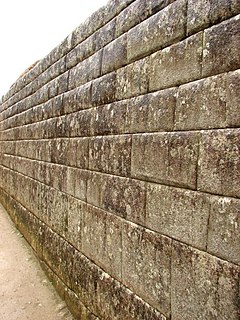
Selimiye Mosque, historically known as Cathedral of Saint Sophia, is a former Roman Catholic cathedral converted into a mosque, located in North Nicosia. It is the main mosque of the city. The Selimiye Mosque is housed in the largest and oldest surviving Gothic church in Cyprus possibly constructed on the site of an earlier Byzantine church.

Sourp Magar is an Armenian monastery located in a forested valley in the Pentadaktylos range in Cyprus. It is de facto located in Northern Cyprus. The Magaravank stands at 530 metres and is about 3 km from the Halevga Forest Station. In addition to its historical interest as a centre of Armenian culture, Sourp Magar is noted for its picturesque location and distant views of the Mediterranean and the mountains in Anatolia. The monastery had close ties with the Armenian Catholicosate of Cicilia, located in Antelias, Lebanon.

The Kyrenia Gate, is a gate in the Nicosia walls, in North Nicosia, Northern Cyprus. It was the gate which was used for transport to the northern areas, especially Kyrenia.

Sarayönü, officially Atatürk Square, is a square in North Nicosia. It is the centre of the Turkish part of the city and was the administrative center of the island for centuries.

Dereboyu Avenue, also known simply as Dereboyu and officially as Mehmet Akif Avenue, is the busiest avenue in North Nicosia, as well as its centre of entertainment. The term "Dereboyu" means "alongside the river", and although in the traditional sense this is only used for Mehmet Akif Avenue running alongside the Pedieos river, the term has expanded in meaning to denote a region extending to the neighbouring Osman Paşa Avenue.
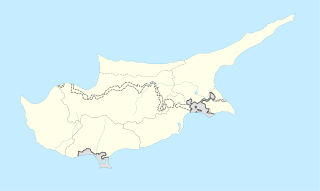
Haydar Pasha is a Neighbourhood, Quarter or Mahalle of Nicosia, Cyprus and the mosque situated therein. Both are named after Haydar Pasha, said to be one of the 12 generals in command of divisions of the Ottoman army at the time of the Ottoman conquest of Nicosia. Each general being posted to a quarter, that quarter was known by his name.
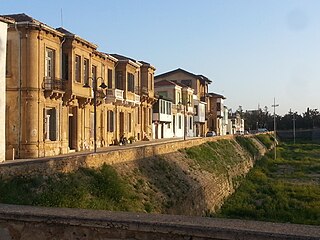
Arab Ahmet is a Neighbourhood, Quarter, Mahalla or Parish of Nicosia, Cyprus and the mosque situated therein. Both the Quarter and the mosque are named after Arab Ahmet Pasha, one of the Turkish commanders in the Ottoman conquest of Nicosia. It is spelled Arabahmet in Turkish and Άραπ Άχμετ in Greek.

Kumarcilar Han is a caravansarai located in North Nicosia, Northern Cyprus. It is unknown when exactly it was built, however it is thought to be built around the end of the 17th century, is much smaller and modest when compared with Büyük Han. Similar to all caravansarai, the entrance leads to an open air courtyard, which is surrounded by a two storey building, originally containing 56 rooms. Those on the upper story were used by the travelers, while those on the ground floor were used for their animals and belongings. Since then, the Kumarcilar Han has entered into a state of disrepair, is in danger of collapse. Efforts to restore the building have been hampered, due to lack of funds.

Büyük Hamam is a Turkish bath in the Iplik Bazar–Korkut Effendi quarter of North Nicosia. It stands close to the İplik Pazarı Mosque. As a result of the rise of the ground of the surrounding areas over time, its door is now located around 2 meters below the ground level, and the bath rooms are 3 meters below.

Kadı Menteş Mansion is a mansion in the Selimiye quarter of North Nicosia. It is located at the intersection of the Selimiye Square and the İdadi Street, and is currently as the headquarters of the Turkish Cypriot Union of Municipalities.
Dükkanlar Önü Mosque is a mosque in the Karamanzade quarter of North Nicosia.

Haydar Pasha Mosque, formerly St. Catherine's Church, is a historic mosque in North Nicosia. It is the most important Gothic building in Nicosia after Ayia Sophia, formerly the Frankish (Latin) cathedral of Nicosia. It has been described by Harry Charles Luke as representing one of the finest examples of Gothic building on the island.

Bedesten or Bedestan is an historical building in the Selimiye quarter of North Nicosia, located directly beside the Selimiye Mosque. The structure has a long and complicated history spanning more than one thousand years. Originally built as a church in about the sixth century, and expanded and rebuilt between the twelfth and sixteenth centuries, it was converted to a bedesten, a type of covered market, during the period of Ottoman rule. It is currently used as a cultural centre.
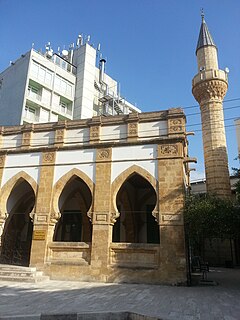
Sarayönü Mosque, also known as the Mosque of the Serai, is a mosque in the walled city of Nicosia, Cyprus, currently located in North Nicosia. It is very close to the Sarayönü Square and has historically been on the square.

Dervish Pasha Mansion is a historical mansion and ethnographic museum in the Arab Ahmet quarter of Nicosia, currently located in North Nicosia. It lies on the Beliğ Paşa Street and has two floors. It is considered to be one of the finest examples of Ottoman architecture in Cyprus.
Namık Kemal Dungeon is a historical building in Famagusta, Cyprus, known for being the abode of influential Turkish writer Namık Kemal between 1873 and 1876.

Palazzo del Provveditore, commonly known as the Venetian Palace, was a royal palace in Famagusta, originally built by the Lusignan Kings of Cyprus. It was later modified and used as the governor's official residence during the Venetian rule. The central sections of the palace have been completely destroyed, with only its grand façade and back courtyard walls being left.

Bayraktar Mosque is a mosque in Nicosia, Cyprus, currently placed in the southern sector of the city administered by the Republic of Cyprus.
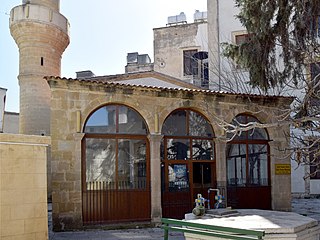
İplik Pazarı Mosque is a mosque in the Iplik Bazar–Korkut Effendi quarter in the walled city of Nicosia, currently located in North Nicosia. It is located on İplik Pazarı Street. Its minaret is one of the very few in Cyprus to have a stone cap.
The Tomb of Kurt Baba is a türbe in North Nicosia. Up until recent times, it was also known as the "Tomb of Kutup Baba" or "Üçler Tomb", but the corruption of the name "Kutup Baba" as "Kurt Baba" stuck as the common name. It is situated in the intersection point of Asmaaltı Street and Kurt Baba Street, and in the corner of Asmaaltı Square.










